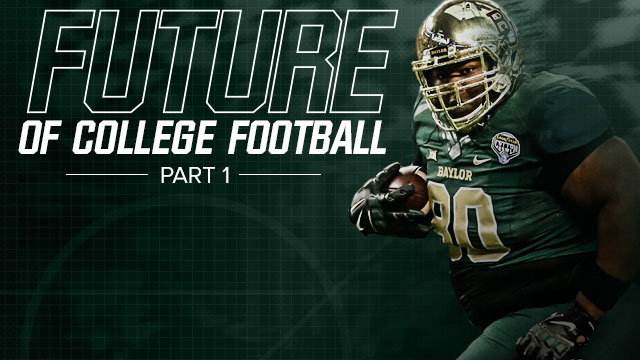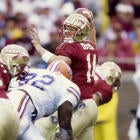WACO, Texas -- The biggest man in college football can be taken down rather easily.
“When I sin, it’s milk,” said Baylor’s massive Laquan McGowan. “I love milk -- ice cream or just 2 percent whole milk.”
Of all the problems the Bears’ 6-foot-8, 408-pound tight end faces -- finding clothes that fit, keeping a diet, managing his weight -- who knew that a little moo juice could slay him?
But dairy is a dangerous craving. When McGowan binges, he will grab a half gallon of milk and chug. Tastes good, feels good and …
“I’m lactose intolerant,” he said. “[It] takes you to the point of no return.”
Then why do it? The answer not only applies to McGowan and dairy products but also his coach and all of college football halfway through the second decade of the 21st century.
All of them do what they do because they can, because limits are being pushed, anything to get an advantage. Even if it hurts. These days, it’s manifest destiny for the sport to conquer everything.
In the year 2015, legal, financial, technological and physical issues are all in play for college football. From hiring general counsels to nutritionists, schools will do anything to gain an edge.
“To me, we’re dealing with 2035,” Baylor coach Art Briles said of McGowan. “We’re dealing the future. We’ve got a physical specimen that plays football that I think will be common 20 years from now.
“If you have a team in 20 years, there will be three or four 400-pounders on it. That’s the way the world is coming. That’s the way football is changing.”
This week, CBSSports.com kicks off its preseason college football coverage with a look at the future of the sport. There are those ancillary issues to be sure, but on the field, the question of how “big” football can get is near the top.
While we consider 2,000-yard rushers, 15-0 champions and billion-dollar television deals, it’s to consider the new college football barrier -- 400 pounds.
“In 20 years, every offensive lineman will look like me,” McGowan said, mimicking his coach.
Briles is staking at least part of his program’s future on that assertion. McGowan caught a so-called “fat guy touchdown” against Michigan State in the Cotton Bowl. But the play was more than a YouTube sensation. It may have been a look inside a lab.
As a fifth-year senior, McGowan is running even with 270-pound Tre’von Armstead atop the depth chart at tight end.
With camp opening this week, McGowan is a manageable weight, a few ticks over 400. His body fat -- about 35 percent -- is consistent with other linemen.
“What it means is he’s got 100 pounds more muscle than everybody else,” Baylor strength coach Kaz Kazadi said. “It moves different; it feels different. He’s in his fifth year, and I’m still learning it. There’s no body like this when it comes to the manual.”
There is no certain way of knowing if McGowan is the biggest player in college football. But you don’t see any other school promoting a nimble 400-pound athlete who runs a 5.32 in the 40 while throwing up 41 reps on the bench (225 pounds).
“He was moving [the bar] like a toothpick,” Kazadi recalled.
“I don’t think he’s just the biggest guy in [college] football,” Briles noted. “He’s probably the biggest guy in football in general.”
The plan is for the converted guard to get 14-25 plays per game as a tight end; Kazadi is talking 40-50. If that makes him a specialist, rock on. Why even bother with a player with that kind of size and weight if he couldn’t play?
McGowan “broke the Internet” with that fat guy touchdown. There is video of him warming up catching balls one-handed. Check out this one of Mr. 400 doing pull ups.
LQ 4plus. WOW!! pic.twitter.com/vvHlvfhP4w
— Randy Clements (@clemo53) July 15, 2015
That alone raises issues of increased mass and force and the safety of players. USC strength coach Ivan Lewis, for one, is skeptical.
“I don’t know about that,” said Lewis while considering a future littered with four-bill linemen. “Four-hundred pound tight ends? How big is the offensive line going to be then?”
There is a hint at left tackle this year for USC. At 365 pounds, left tackle Zach Banner is the Trojans’ biggest player.
Arkansas’ starting offensive line, which just happened to be featured on the cover of its 2015 media guide, weighs a combined 1,600 pounds.
“It’s like training a big, old basketball player,” Lewis said. “You can’t train them traditionally. They don’t squat. A lot of those guys have hip impingements, lower back [problems]. You’ve got to look at different ways to train them.”
For all the scoreboards Briles’ Bears have broken, Baylor has a bludgeoning quality to it as well.
The Bears have won at least a share of two straight Big 12 titles with giants walking among their ranks. Three-hundred pound defensive tackle Andrew Billings runs a 4.94 in the 40 and vertical jumps 32 inches; he chipped in last season with 11.5 tackles for loss.
Defensive end Shawn Oakman (6-foot-9, 280 pounds) set the school sack record with 11 takedowns last season. Oakman, who is at the top of every media member’s “freak” list entering 2015, surprisingly returned for his senior season after posting 19 tackles for loss.
Former defensive end Phil Taylor came to Baylor at 400 pounds. He left at a lithe 335 pounds as a first-round NFL draft pick with an All-Big 12 honor. Current All-American Spencer Drango is relatively average these days for his position at 6-foot-6, 310 pounds.
“We’re not waiting for everybody else,” Kazadi said. “You’ve seen the guys [Briles] brings in … How many schools have had two 400 pounders on the same team?”
McGowan was recruited as an offensive lineman out of Cal Farley’s Boys Ranch near Amarillo. His mother placed him there at age 10 to get McGowan -- an only child -- away from a sketchy Metroplex neighborhood.
“For a kid to grow up in South Dallas is not an ideal way to grow up,” said McGowan, who then added, “[but] I don’t think I would necessarily give my child away.”
Farley’s takes in at-risk children. McGowan grew up there in more ways than one. Football didn’t interest him because of the work and contact involved.
He was attracted to basketball, especially when -- one day -- two used pairs of size 23 Nikes showed up in the mail … from Shaquille O’Neal. An official from Farley’s had reached out, desperate for help.
“I wore [those] shoes out within the first week,” McGowan said.
McGowan is freakish only in ability. He doesn’t look overweight. His poundage fits his frame.
“A lot of people tell me that,” he said. “That scale is telling me something different.”
Informed that Jameis Winston ran a 4.97 40 at the combine, McGowan brightens as if could take the No. 1 overall pick in a foot race. At Baylor, coaches noticed how adept he was at catching. His size was so intimidating, there was little contact in practice.
“Don’t try to put anybody on the ground or fall on anybody,” McGowan recalls of instructions he received.
Was that to protect him, his teammates or both?
“Both, but more them than me,” he quipped.
The battle of his bulge has a happy ending at this point. McGowan said he once weighed 440 pounds while at Baylor. On a good day, he’ll adhere to a lean Subway diet or cook up some combination of chicken breast, rice, fish and broccoli.
It’s the dairy that brings him to his knees. Even the paradigm for the future of college football has a weakness.
“You’re going to make me go home,” McGowan said as a recent interview wrapped up, “and have some cheese.”






















